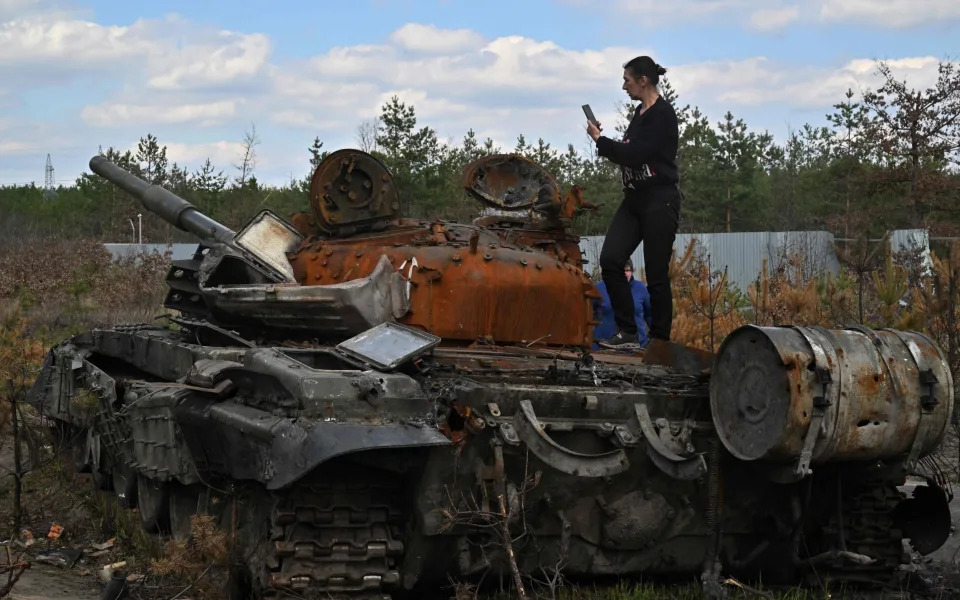The Telegraph
Around 15,000 Russian troops have died since Ukraine invasion began, says Ben Wallace
Roland Oliphant – April 25, 2022

Some 15,000 Russian troops have been killed in the two months since Vladimir Putin launched his invasion of Ukraine, the Defence Secretary said on Monday.
Ben Wallace told MPs that more than 2,000 of Russia’s armoured vehicles have either been destroyed or captured as he outlined further UK support to Ukraine to help defend its territory.
With Russia switching its attention to the Donbas region in the south-east, Mr Wallace said Britain would supply Ukraine with armoured vehicles mounted with anti-aircraft missiles to help it fight off the assault.
He told the Commons that Stormer armoured vehicles would carry Starstreak missiles, a shoulder-launched version of which was supplied to Ukraine earlier this month.
“In response to indiscriminate bombing from the air and escalation by President Putin’s forces on March 9, I announced the UK would supply Starstreak high-velocity and low-velocity anti-air missiles,” Mr Wallace said.
“I am able to now report to the House that these have been in theatre for over three weeks and have been deployed and used by Ukrainian forces to defend themselves and their territory.
“As we can see from Ukrainians’ requests, more still needs to be done. So for that reason I can now announce to the House that we shall be gifting a small number of armoured vehicles fitted with launchers for those anti-air missiles. The Stormer vehicles will give Ukrainian forces enhanced, short-range anti-air capabilities, both day and night.”
The Alvis Stormer is a lightly armoured, tracked vehicle that first came into service with the British Army in the 1970s. It can be used in a variety of roles, including to engage ground targets, lay mines or retrieve disabled vehicles.
The version to be supplied to Ukraine is effectively a mobile anti-aircraft platform with a Starstreak battery mounted on the roof. It will grant the Ukrainians greater mobility to respond to aerial threats as the battle in the open landscape of the Donbas escalates.
The provision of vehicles reflects a growing belief among Western governments, which initially expected a quick Russian victory, that Mr Putin’s invasion is failing and can be defeated on the battlefield.
Mr Wallace told the Commons that British assessments were that “alongside the death toll are the equipment losses and in total a number of sources suggest that to date over 2,000 armoured vehicles have been destroyed or captured”.
He said: “The offensive that was supposed to take a maximum of a week has now taken weeks.”
The Defence Secretary added that Russia had deployed more than 120 battalion tactical groups, or around 65 per cent of its ground forces, to the war. About 25 per cent had been rendered “combat ineffective” during the past two months of fighting.
Starstreak missiles accelerate to Mach 4 after launch, making them the fastest of their type in the world and especially difficult for targets to evade. However, they are short-range and can only engage relatively low-altitude targets such as Russia’s KA-52 helicopters and SU-25 ground-attack jets.
Separately, Boris Johnson announced that more than 40 fire engines and 22 ambulances will be sent to Ukraine to help keep the country’s emergency services functioning.
Some £300,000 in funding will be given to the front line medical aid charity UK-Med to help train Ukrainian doctors, nurses and paramedics in dealing with mass casualties.
The Prime Minister said Britain had been “appalled” by the targeting of hospitals by the Russian troops, and expressed hope that the support would help save the lives of Ukrainians. Other items donated alongside the fire engines include rescue equipment, thermal imaging cameras for finding victims, around 300 fire hoses and 10,000 items of protective equipment.
Mr Johnson said: “We have all been appalled by the abhorrent images of hospitals deliberately targeted by Russia since the invasion began over two months ago.
“The new ambulances, fire engines and funding for health experts announced today will better equip the Ukrainian people to deliver vital health care and save lives. Together with our military support, we will help to strengthen Ukraine’s capability to make sure Putin’s brutal invasion fails.”
